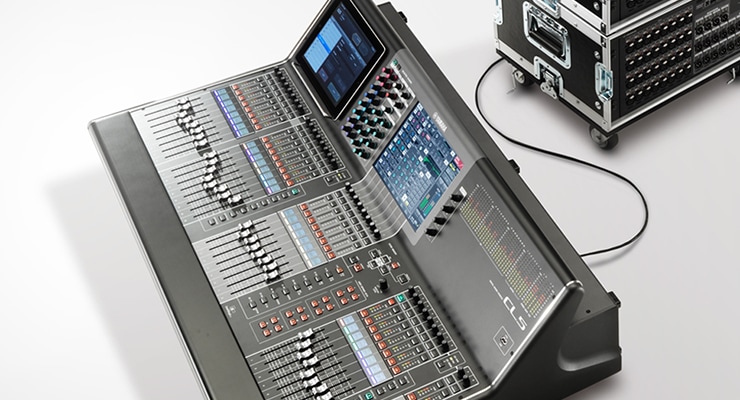Better Sound for Commercial Installations
Part 1: Sound Basics
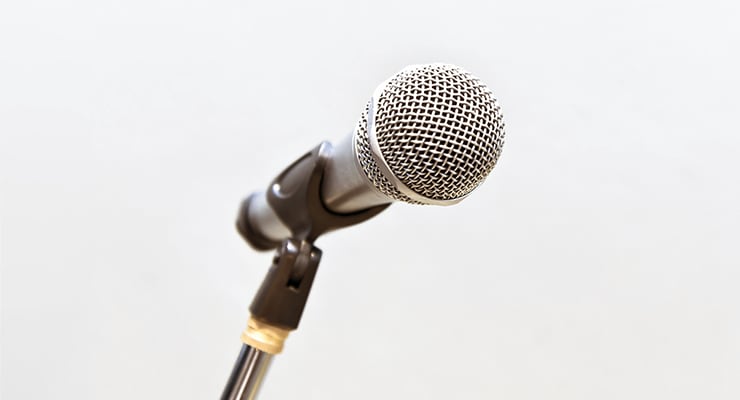
02. Sound Systems
The part of a sound system that is most obvious to casual listeners who are not involved in the sound business is probably the speaker system that produces the sound output that we hear directly. The speaker system is actually only the last in a chain of several devices that amplify, route, and process the sound signal.
Sound Systems Consist of Four Main Stages
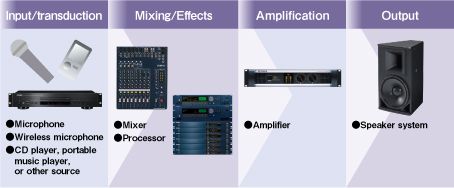
In simple terms, the role of a sound system is to amplify and adjust the sound quality of an audio signal, and then provide corresponding output from the speaker system that the listeners will hear. We've organized the basics of that process in graphic form below. The system can be broadly divided into four stages: input/transduction, mixing/effects, amplification, and output. (Figure: The Stages of a Sound System) Let's look at each stage, from left to right.
(Figure: The Stages of a Sound System)
(1)Input/Transduction
The first step is to convert the source sound to an electrical signal that can be fed to the rest of the system by using a microphone or playback device.
Microphone:
The microphone is a true "transducer" that converts acoustic sound transmitted via the air into electrical signals that can then be processed and amplified by the system. Here's how a dynamic microphone - a type of microphone commonly used in sound systems - accomplishes that task.
As we learned in the previous section, sound is transmitting as vibrations through air. Those vibrations - the sound waves - travel though the air and cause the microphone's diaphragm to vibrate. The diaphragm is attached to a voice coil (a coil of wire) that vibrates within a magnetic field provided by the microphone's magnet, thus generating a corresponding electrical signal. Basically the same process happens in reverse in the speakers at the end of the audio chain.
Audio Players:
These devices convert sound data encoded on a recording medium into an electrical signal that can then be processed and amplified by the system. Some of the most familiar players are CD players, portable digital audio players, and of course older analog cassette decks and record players are included in this category as well. Radio and TV tuners are also types of audio players.
(2)Mixing/Effects
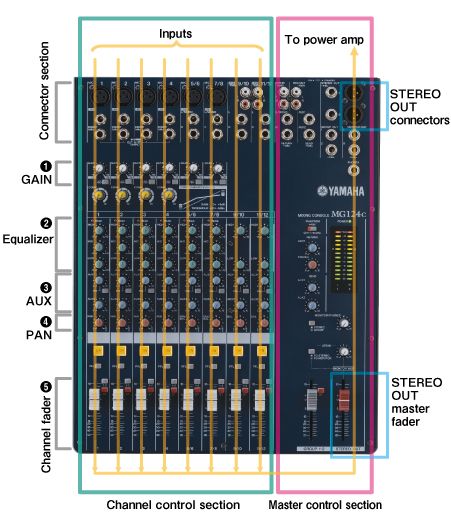
Electrical audio signals derived from the input sources are then fed to a mixer or processor that might mix a variety of input sources and/or add effects.
Mixer: This device can be used to mix multiple audio signals while adjusting their relative levels and independent sound quality. Let's look at the functions of a basic mixer, using the Yamaha MG124C as an example.
Channel Control Section: The channel control section includes individual controls for the input sources fed to the mixer, allowing adjustment of level (volume) and tone for each input signal. The following controls are commonly provided for mixer input signals:
1. Gain
Microphone signals are of a much lower level than the output from audio players (line-level signals), and must be amplified via the mixer's preamplifiers (also known as "head amplifiers") to raise them to an appropriate level. The Gain control adjusts the amount of pre-amplification applied to low-level input signals.
2. Equalizer
Many mixers feature three or four band equalizers on each input channel that can be used to tailor the sound for the best blend with the other input signals and/or to reduce feedback. More information on equalization will be provided in "Processing Types" and "Controlling Feedback (Using the Graphic Equalizer)" in Part 3.
3. Auxiliary Sends
Auxiliary sends are like "branches" off the main signal flow that will eventually reach the main power amplifier and speaker system. They can be used to divert some of the signal to external effect units, or to the performer's monitor system.
4. Pan
When the main output is being delivered via two speaker systems in a stereo configuration, the Pan control adjusts the relative levels of the corresponding channel signal sent to the left and right speaker systems. It can be used to adjust the apparent position of the corresponding input signal in the final stereo mix.
5. Channel Fader
The channel faders are used to adjust the level of each input signal. The main reason for doing this is to adjust the balance between the various input signals to create the desired "mix." The signals are electronically combined at the specified levels.
Master Control Section: The overall level of the mixed input signals is set by the STEREO OUT master fader, and the resultant signal is output via the STEREO OUT connectors which can be connected to the power amplifier inputs (the next "stage" in the system).
Processor: Processors are used to manipulate the electronic audio signal in some way, often to add effects. Processors are commonly used to increase the intelligibility of the signal and to create as natural a sound as possible. Effects are also sometimes used as creative tools. More details are provided in "Processing Types" in Part 3.
(Figure: MG124C Control Panel)
(3)Amplification
The power amplifier amplifies the mixed and processed audio signal to a level that is sufficient to drive the speaker system. The power amplifier or multiple power amplifiers are usually placed out of sight and are easy to overlook, but they are a vital part of the overall system, handling higher voltage and current than any other component.
There are 2-channel power amplifiers that can independently amplify two channels of audio, and multi-channel amplifiers that can amplify four or even eight channels of audio. Two-channel amplifiers are usually used to handle stereo music or similar program material, while multi-channel types provide the capability to drive more speaker systems in a relatively small amount of rack space.
(4)Output
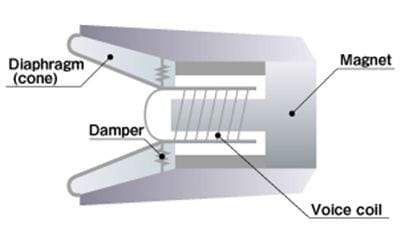
The last stage in the sound system consists of the speakers that convert the amplified electrical output from the power amp back into acoustic sound that we can hear. The mechanism by which the electrical signal is converted back to acoustic sound is essentially the reverse of the microphone discussed earlier. You can see the similarity in the dynamic speaker diagram, the type most commonly used in sound systems, below right.
The output from the power amplifier is fed to the speaker's voice coil, where it interacts with the magnetic field surround the voice coil to produce corresponding physical motion. At this point the electric signal has been converted back into a mechanical acoustic energy, but the voice coil alone is not capable of producing the required sound pressure levels. The voice coil is attached to a cone that is capable of moving considerably more air, and it is primarily the speaker's cone that directly drives the air to produce the sound we hear.
Dynamic speaker units are usually not used in their "naked" state, but rather one or more units will be housed in an enclosure designed to provide the required overall output characteristics. The speakers alone are "units," but once installed in an appropriate enclosure the assembly becomes a "speaker system."
(Figure: Dynamic Speaker Construction)
That completes our simple sound system overview. Although the details will change considerably according to the type and scale of the application for which the system is designed, the basics remain pretty much constant. In the next few sections we'll discuss some of the applications for which sound systems are used.
Contents
The sound systems that broadcast the information you're hearing have been carefully designed and installed to suit the needs of each individual facility.
This series offers information aimed at achieving the best possible sound in commercial installations, from the basics to equipment selection and day-to-day operation.


